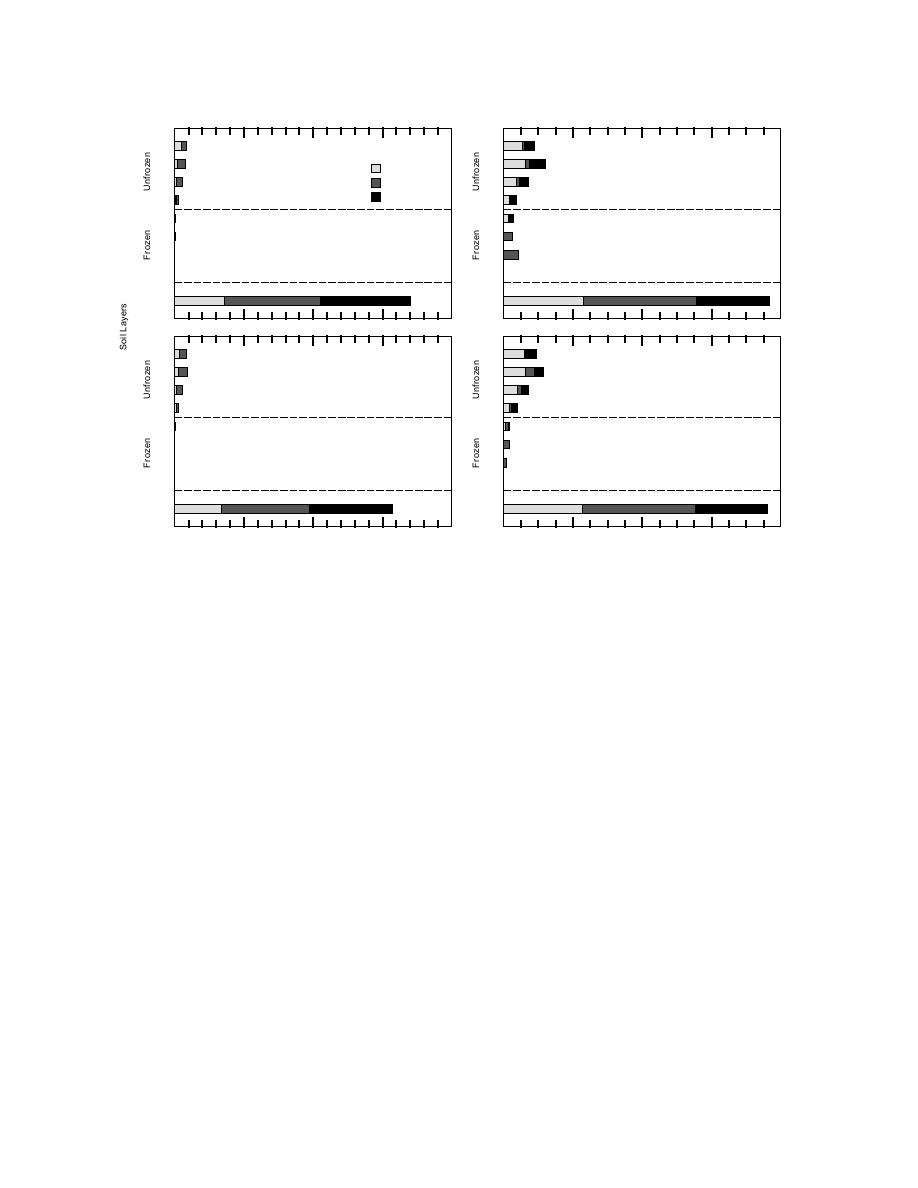
Treatment 1
Treatment 2
S1
S1
a. Chamber 1
b. Chamber 2
S2
S2
RDX
S3
S3
Picric Acid
TNT
S4
S4
S5
S5
S6
S6
S7
S7
S8
S8
Total
Total
Added
Initial
S1
S1
c. Chamber 3
d. Chamber 4
S2
S2
S3
S3
S4
S4
S5
S5
S6
S6
S7
S7
S8
S8
Total
Total
Added
Initial
0
10,000
20,000
30,000
40,000
0
40,000
80,000
120,000
160,000
Soil Content (g)
Figure 4. Distribution of RDX, picric acid, and TNT in soil layers at the experiments' conclusion.
L1), a high percentage of picric acid (4560%) was
Mass balance
recovered during the periodic samplings of the aque-
At the end of the experiments, an effort was made to
ous phase for both treatments (Fig. 5b). A significant
account for the mass of explosives either initially present
amount of picric acid leached into the frozen soil layer
in the chambers as contaminated soil (Treatment 2) or
in Treatment 2, again because of the thawing of this
added to the chambers as contaminated solution (Treat-
layer when the contaminated soil was added. In con-
ment 1). Compartments were aqueous (recovered in
trast, little of the highly soluble picric acid leached into
periodic samplings), unfrozen soil, frozen soil, and
the frozen soil in Treatment 1, where the explosives
"missing" (the difference between what was present
were added in aqueous solution after stabilization of
initially or added and the final recovery). The recovery
the frozen barrier. Similar amounts (1825%) of picric
patterns were similar within treatments, but quite dis-
acid were missing in the two treatments (Fig. 5b).
similar between treatments (Fig. 5).
Approximately 12% of the TNT in Treatment 1 was
In Treatment 1 (Chambers 1 and 3), there were simi-
lar amounts of RDX (≈ 33%) in the aqueous, unfrozen
recovered in the aqueous phase; virtually everything
else was missing (Fig. 5c). In Treatment 2, about 56%
soil, and missing compartments; almost no RDX
of the TNT originally present in the contaminated
leached into the frozen soil compartment. In contrast,
(unfrozen) soil remained in these soil layers at the con-
for Treatment 2 (Chambers 2 and 4), about 75% of the
clusion of the experiments. About 12% of the TNT in
RDX was found in the unfrozen soil; little RDX was
Treatment 2 was recovered in the aqueous phase. A
removed with the periodic aqueous phase samplings.
small amount of TNT leached into the frozen soil in
The amount that was missing in Treatment 2 (15%) was
Treatment 2, and about 30% was missing (Fig. 5c).
about half of the missing compartment of Treatment 1.
There was minor movement of the RDX into the fro-
zen soil layers in Treatment 2 due to thawing of the
DISCUSSION
frozen layer when explosives were added.
Efficacy of frozen barriers
Because of the high solubility of picric acid (12,400
Ideally, frozen barriers for restraining explosives
mg L1) relative to RDX (45 mg L1) and TNT (150 mg
6



 Previous Page
Previous Page
